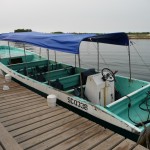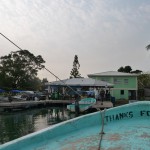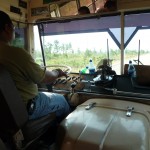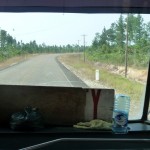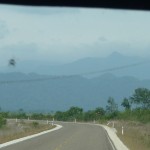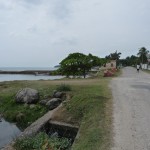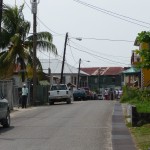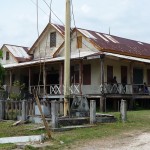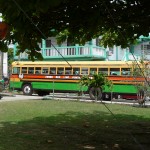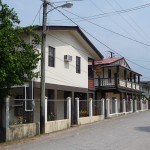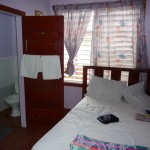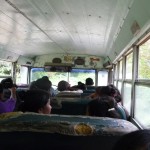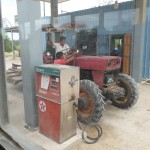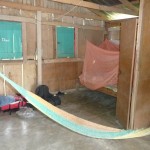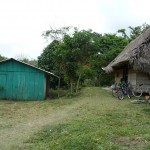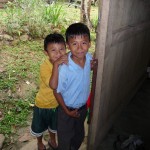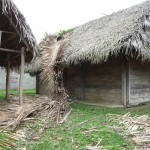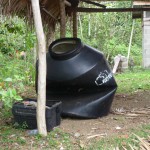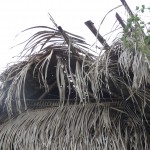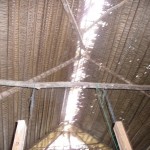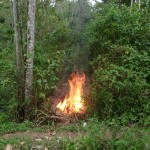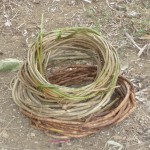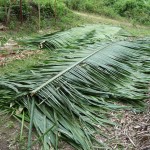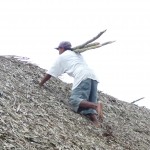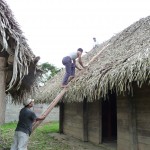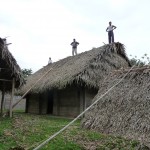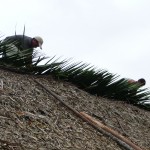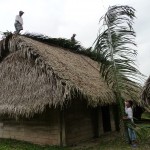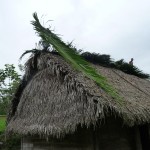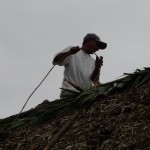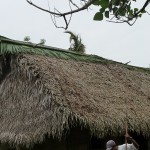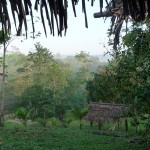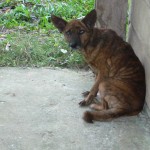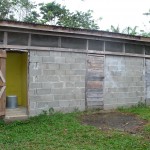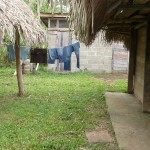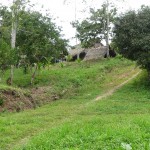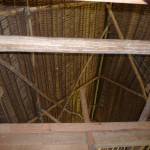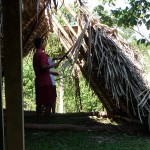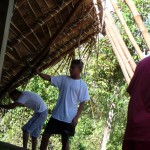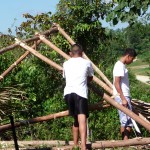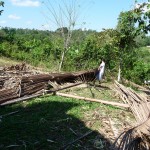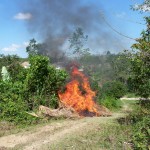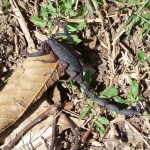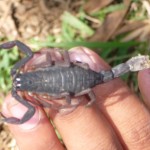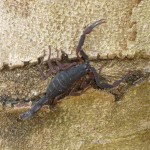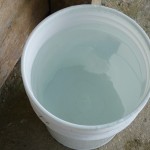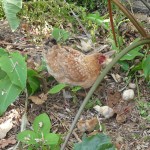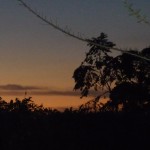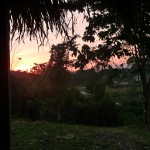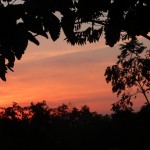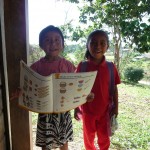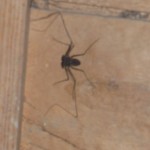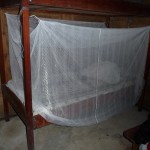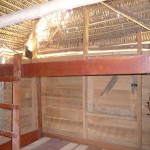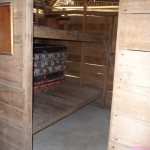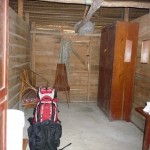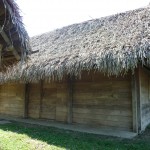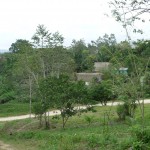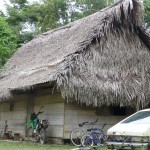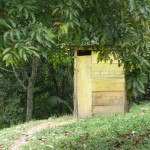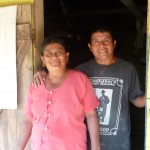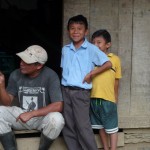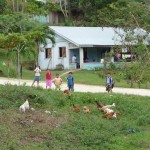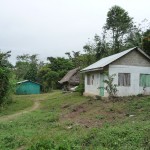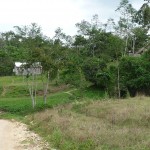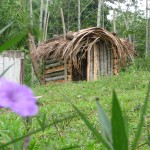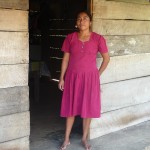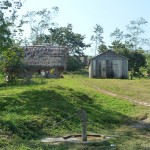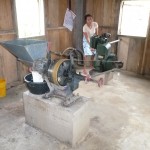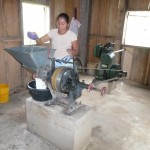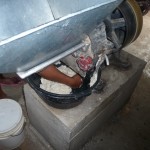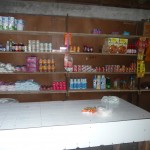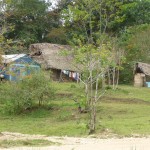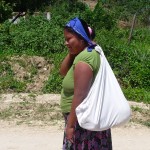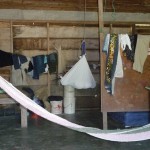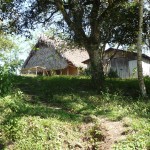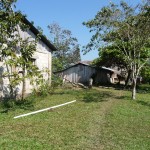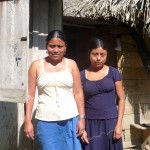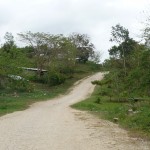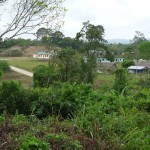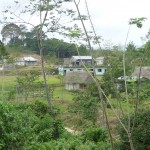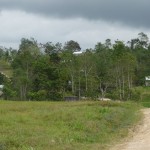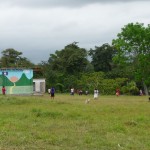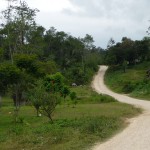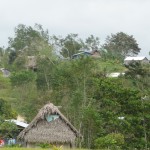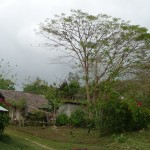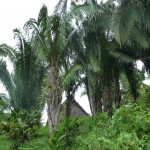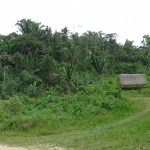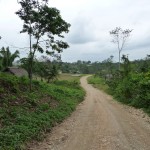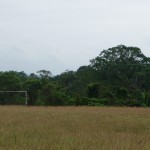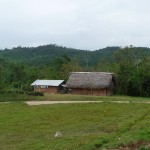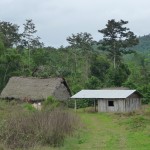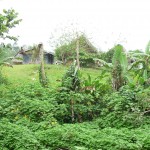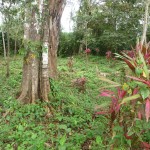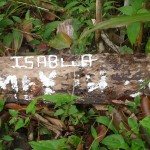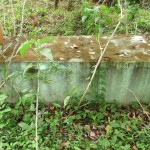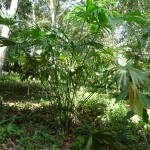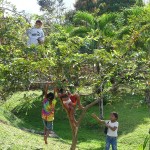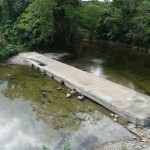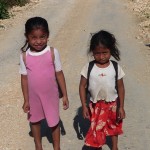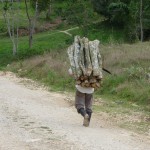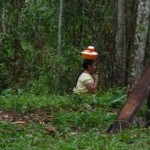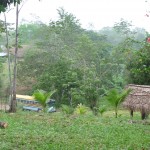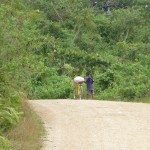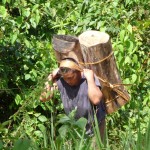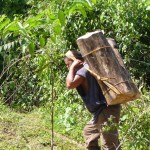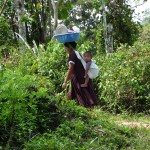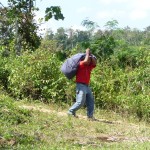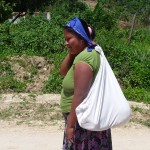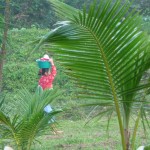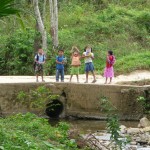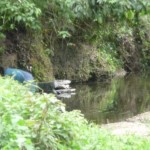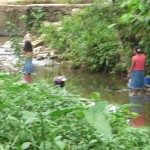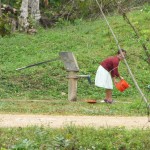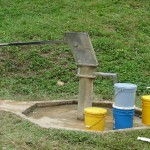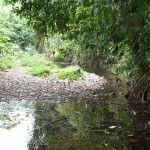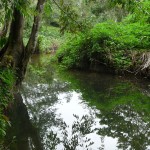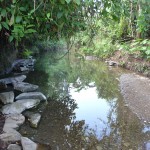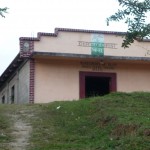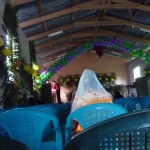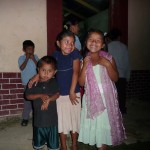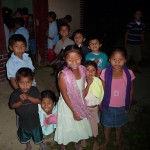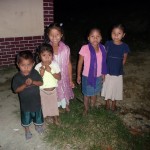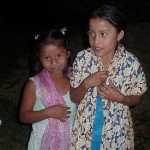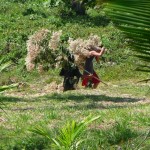During my growth-filled nine days in the tiny Mayan village of Santa Elena, I literally took hundreds of photos. While organizing them, labeling, them, and uploading them, I simply could not narrow down the list to less than these 224 photos.
The photos will be posted in two groups, due to the quantity. As usual, you can click on any photo to see a more detailed high-resolution image. What is displayed here on the page is simply a thumbnail of the photo itself.
Enjoy!
Journey From Placencia
This is the little “Hokey Pokey Water Taxi” that carried me from the town of Placencia, situated on a long penninsula, over to the mainland town of Independence, in preparation for my bus ride to Punta Gorda.
In this photo, our little water taxi is just about to pull up to the pier on the mainland–in the small town of Independence. After sitting at a bus stop for over an hour, I catch an old second-class school bus heading south.
This is my view of the bus driver inside the rickety old bus.
A view out the front window of our bus as we head toward the southern end of Belize. I was amazed when I saw these pine trees by the sides of the road.
And then there were the mountains in the distance. In Cozumel and the Yucatan, mountains are non-existant. I did not realize that Central America had such tall mountains.
Punta Gorda
Punta Gorda sits right on the ocean, near the southern end of Belize–but there are not really any swimmable beaches here. This photo is taken at the southern end of town–the ocean waters on the left, a small road on the right.
A typical street in this quaint little town of approximately 6,000 residents.
An interesting building near the ocean front. This one, as is quite common, is built on stilts.
This colorful bus looks very similar to the one that I rode from Independence to Punta Gorda. This photo was taken the next day, at about the same time that I arrived–so perhaps it is the same bus.
A street view of the St. Charles Inn. I stayed at this small hotel on both the night before and the night after my amazing nine days in Santa Elena.
Room #11 — the bed mostly fills this tiny room. While the bed sags slightly, and the building is very old, this little room provided a very nice place to sleep during both of my short stays in Punta Gorda.
Journey to Santa Elena
This is the old beat up interior of the rusty school bus that took me on the 1.5 hour drive to the village of Santa Elena. I didn’t even think to capture a photo of the large sacks of grain that were stacked up in the aisles between the rows of seats.
This is the silt-covered gas pump where we stopped to fill up the bus before leaving the highway and heading out on the dirt roads in the mountains. I love this big old tractor on the other side.
Night #1 at Dionicio’s Home
This is the inside of Filimon’s room–the place at Dionicio’s home where I spent my first night in Santa Elena. The guest house roof was damaged and I was unable to sleep there.
Notice the white lines around all the boards in the walls. Yes, that is the glow of sunlight through the gaps between boards. This particular hut had a corrugated metal roof–but as you can see, there is a great deal of sunlight glowing under the edge of the roof as well.
That is my bed covered by the reddish-orange mosquito net.
The blue-green building on the left is where I slept. The thatched roof building on the right is another of the huts on Dionicio’s property. This is the place where I called out “Hello” during my first moments in the village, hoping to find friendly faces and a friendly welcome.
Leroy and Elroy posing in the doorway of the blue-green building. These two cute little boys are Dionicio’s grandsons. Leroy is the older boy. They loved to stand in my doorway and giggle at me.
The Wonderful Guest House
A photo of the guesthouse before the roof was repaired. All of the scattered branches came from the top of the roof, where the protective cap blew off in the same windstorm that nearly blew our tents away during the second night of our sailboat adventure in tobacco caye.
This bent-up water tank still sits under the little outdoor patio in front of the guest house. This tank used to sit just left of the outhouse building in the background. Rainwater was collected in the tank, providing water for a shower in the block building–a shower which is no longer functional. Dionicio tells me that this tank was filled with water when it fell off the platform, getting crushed. Aparently, this happened during a different storm.
Another angle of one end of the rooftop, prior to the repairs. If you look closely, you can see daylight where there should be darkness.
In this more dramatic shot taken from inside the guesthouse, you can clearly see the damage. This photo is taken from the floor, looking up at the thatch roof.
Part of the old roof, being burned in the jungle. Even with these very hot flames, the surrounding foliage did not catch on fire.
Several bundles of vines gathered in the jungle. These vines are used to tie off the branches and poles as the roof is repaired.
A stack of palm branches waiting to be lifted up onto the rooftop. These branches (and others) were carried here by Teodora’s elderly husband. I watched him carrying them out of the jungle on his back, pulling them across the village. These branches are very big, at least fifteen feet long, and they weigh alot too.
The first young man to climb onto the roof. He shimmied up a single long pole and then scaled the remainder of the steep roof with his bare feet.
Dionicio (bottom), and another man scaling their way to the rooftop. By now, there are two side-by-side long poles on which they climb. The first young man is already on the top, on the far end.
The three men, standing evenly spaced on top the roof. Notice in the foreground on the right. This peaked roof used to be another shade structure like the one of the left. It also blew over in the previous week’s strong winds.
Beginning to place palm branches on top the peaked roof.
Dionicio’s son handing up another huge branch.
The branch being pulled up onto the roof.
I didn’t know him at the time, but as I study this young man’s face, it looks like Mateus, Glenda’s husband. He is busily tying off the poles on the roof, using some of the vines from the previous photo.
The completed roof, now ready for occupation. The rain will no longer penetrate.
A portion of the beautiful and mystical panoramic view from the porch at the guesthouse. The road and stream cross at the bottom left of the photo. A small rooster can be seen in front of the shade structure near the bottom right.
The sickly, itchy little dog, sitting at the end of the porch in front of the guesthouse, rubbing his back against the boards.
The outhouse building at the guesthouse. The left door is open, showing the fiberglass throne. The middle door leads to a non-functional shower system. The right door leads to another hole in the ground.
My clothes drying after hiking through the jungle and climbing on hands and knees through muddy caves. I washed these in a bucket.
A view of the small path leading up to the guesthouse which is in the center of the photo at the top. To add perspective, the small stream is to my right, the dirt road is directly behind me, and Christina’s home is to my left.
The inside roof of the guesthouse after having been repaired.
A few days later, two of Dionicio’s sons, and another young man, came over to tear down the fallen shade structure on the west end of the guesthouse. Here, they are chopping the vines that hold the palm branches in place.
Branches on one side have been removed. Now they are working on the other.
Dismantling the peaked A-frame structure itself.
Carrying off the huge dry palm branches, preparing to burn them.
Let the flames begin! They were huge, and extremely hot–helping to dry the fresh coat of paint on my toenails.
The very large scorpion, with its stinger still intact. The body was over two inches in length, with the tail at least another three inches.
As I look at this photo of the stinger-less scorpion crawling on Filimon’s hand, I realize that maybe the scorpion is not as big as I thought. The body appears to be two fingers in width–perhaps 1.5 inches. The tail, before the stinger was broken off, was at least 2.5 inches.
The scorpion has been released. He is now climbing on the bark of a nearby tree trunk.
A five-gallon bucket filled with well water. While I didn’t drink this particular water, Heralda (Dionicio’s wife) boiled some well water for me to drink. It had a very strong metalic taste–but proved to be safe for my stomach.
I washed several times using such water from the bucket.
One of many hens (and roosters) that loved to wander around the guesthouse. If you look closely, you can see several baby chicks gathered around her.
Sunset from the guesthouse porch.
Another view of sunset from the porch. This shows a little more of the village in the distance. The soccer field is between the trees in the middle of the photo (can’t really see it here). The school is barely visible in the far right of the photo, right in the middle.
Yet another sunset photo, showing the colorful skies.
Rosaria (five years old) and her friend, saying “Take my picture, Miss”. These darling girls visited me several times after Sunday night. They were such angels.
I found this lovely little visitor on the guesthouse door one evening. (sorry, it is out of focus). He was several inches from leg tip to leg tip. Dionicio later tells me that they are quite common in the homes, and are completely harmless.
He sure freaked me out.
My bed in the guesthouse, with my white mosquito net.
The other unused bunkbed in my end of the guesthouse. Notice how much open air is exposed above. The roof above extends well over this open area, keeping the rain out, but the room is definitely open to ventilation, plus invasions by unidentified crawling critters.
A glimpse of the double-wide bunkbed in the other end of the guesthouse. Again, notice how much open air there is in the ends of the roof overhang. Also, notice how you can see air between the boards.
The middle reception area of the guest house–with two large cabinets, a table, a small padded bench, and a couple of folding wooden chairs. One of the wooden chairs is visible in the back. And then, of course, there is my red backpack.
Another view of the guesthouse exterior, up close. You can see the small slab of concrete in front that I call my “porch”. I thought it was about four feet wide, but this photo makes it look like maybe it is only three. The door in the middle is the only entrance. My room was on the far left.
Dionicio’s Home
This is a photo of Dionicio’s cluster of buildings as seen from the guesthouse porch. Note, the small dirt road running through the center of the photo. You can barely see the edge of Christina’s store on the far right (foreground). The well is by the road, down below the store.
One of the huts on Dionicio’s property. Notice that the kids have bicycles, and that someone used to have a car which has long since become unusable. Dionicio also has a motorcycle which he occasionally uses to visit a neighboring village.
Dionicio’s outhouse — my first-night bathroom.
Dionicio and Heralda in their front entryway. Not the best photo in the world. The lighting is a little off, but you can get the idea.
Dionicio with Leroy and Elroy, two of his grandsons.
This is not actually a photo of Dionicio’s home. It is taken from Dionicio’s property, looking out toward the road. The children were fascinated by me, and I was fascinated by the chickens clucking around, looking for worms and bugs.
This is a from-the-street view of Dionicios bottom two buildings. He has two more above the thatched building in the back. The building in the front right is not Dionicio’s. This is where the village women used to meet to grind corn. This block building is where Dionicio and his family slept on the floor after their other buildings burned down about four or five yhears ago.
Christina’s Home
This photo shows Christina’s property (from afar). The building on the left is her store. Up on the hill to the right, you can barely see the guest house.
A cute thatch-roof doghouse on Christina’s property.
Christina in the doorway of her home.
My best photo of Christina’s home. In the foreground is the well by the road. On the left is her one-room house. On the right is her one room store, where the noisy corn mill is located.
This is Christina’s fancy Corn mill–where all of the village women come to grind their corn. In the back is the gasoline engine with the huge pulleys and belts that drive the mill at the left front.
In this photo, Christina is starting the engine using a hand crank to turn it. It takes her several forceful tries before the engine begins to loudly roar. (sounding like a loud lawn mower engine.)
Christina is pouring a bowl of water onto the wet whole kernels of corn. The corn is ground wet, producing a wet-doughy mixture that is used to make tortillas. No other ingredients are added–simply corn and water. After the dough is flattened and fried over a fire–the result is delicious. Soft, light, and very tasty. I have never tasted corn tortillas so good (normally I don’t like them).
This is not the best photo, but if you look closely, you can see Christina’s forearm working with the moist dough in the bin below the mill. She is removing the dough, preparing to put it back into the bowl of the woman who brought the corn to be ground.
Christina charges ten cents (BZ) per pound of corn ground. This equates to five cents US.
This is the extent of Christina’s meager store. She sells only the basic staples, toilet paper, and cleaning supplies. There are a few bins below the table which I assume may contain flour and rice.
Glenda’s Home
This beautiful little property belongs to Mateus and Glenda (Dionicio’s daughter). They bought this land and home about nine months ago. I believe the told me that they paid about $1,500 Bz ($750.00 US).
The little blue walled, metal roofed structure to the left is where Glenda fed me my meals. It has a concrete floor, a small table with chair, a hammock, and a bed in the far corner. Glenda tells me that the thatched-roof building to the right is her kitchen. The floor of the kitchen is rough, uneven, dry dirt.
This is Glenda, carrying her baby Marlene. The baby is bundled up tightly in the white bag. If you look closely, you can see that the blue scarf is supporting the entire weight of the baby, which is hung over the top of Glenda’s head, just above her forehead.
This is the inside of Glenda’s home, in the building where she fed me. The baby is hanging in the white bag in the middle. Glenda’s bed is hidden behind the small room divider.
Irma’s Home
This is a photo of Irma’s property high up on the crest of the hill at the western border of Santa Elena. I never got a photo of Irma or Justo. I went to her home on my last day, with intentions to get a photo, but she was already out in the farm.
The thatched room structure on the left is where she fed me. It has dirt floors, and very meager furnishings. Irma cooked for me on a small open fire inside the building.
Teodora’s Home
This is Teodora’s property. The house in the center background is where I was fed. It too has only a dirt floor, and very little furniture–mainly a bed and a table.
Just like with Irma, I put off trying to get a photo of Teodora until it was too late. In this photo are Juliana (Teodora’s daughter) and Lavina (her daughter-in-law). Juliana is the taller, older girl.
Around The Village
This is the little dirt road that runs through the center of the village. This photo is looking east, toward the edge of the village at the top of the hill. The little path leading to the church is about half way up the road on the left.
This photo was taken from next to the guesthouse. It shows my view of the village to the west and north. The wide blue structure just above the middle and slightly to the right is the school. Above the far hill with the bare sides is the small buriel ground. In front of that hill is the soccer field. The prominently visible building at the upper left center is an old abandoned church. Left of that building, you can barely see the shine of a large concrete slab. This is where Brenda was drying her cacao seeds.
This photo is a slightly zoomed in view of the center of the former photo. The school is the wide blue building in the middle.
Part of the village, looking from the west side, toward the east.
The school playground, with many children out playing. The words above the large Mural read “Santa Elena RC School”. This is just one end of the three-room schoolhouse.
This is a view of the road leading up to the western edge of the village. Irma’s home is at the top of the hill on the right. Glenda’s is nestled in the trees on the left, just to the left of where you can barely see a horse grazing by the road.
Many of the villager’s homes, scattered around on the hillside on the east end of the village.
I love this photo of some of the beautiful scenery in the village.
Branches from these tall palm trees are what people use to build their thatch roofs here in the village.
More beautiful views in the village (and they say that this area is not part of the jungle).
Looking from the hill on the west end of the village, back down to the east.
The large soccer field.
A beautiful home along the road.
Another cute little two-building home.
More beautiful scenery from around town.
This photo is from a small buriel ground high above the hill on the west end of town, just above the soccer field.
A wooden marker laying on the ground above one barely-marked grave.
One of two such concrete casings in the buriel grounds.
This cute little palm-like plant is called Jippi Jappa. I ate many a meal with Jippi Jappa being the main course. The portion I ate was from the young tender portion of the bottom of the stalks. The older more mature portions of the stalk are dried and used to make baskets.
A group of beautiful children playing in a tree.
During my hike to the ruins near Santa Cruz, I passed this tiny concrete bridge, just east of Santa Elena. It is no longer used for traffic. This larger slow-moving river is the Rio Blanco.
Two of the cute little angels running around the village. The tiny one looks very much like the little one that first started bumping my hand in church on Sunday night (but I’m not quite sure if it is her).
Transportation Options
I am constantly amazed at the huge weights I see some of the men carrying on their backs. This large bundle of small logs cannot be easy to carry.
Women very commonly carry things on their heads. This woman is carrying a load of freshly ground cornmeal back to her home.
One of the few buses that pass through the village every day.
This young boy is carrying a huge sack full of beans home on his bicycle. He suspends the beans above his handle bars. With each uphill hike he gets off the bicycle and pushes. With each downhill stretch, he zooms down on his bicycle. I saw him make several runs with his bicycle in a few hour period.
This man amazed me as he walked up the trail near the guesthouse. He was carrying these two enormous logs on his back, with all of the weight suspended from a strap over the top of his head.
I was so impressed by this man that I just had to get a photo from a slightly different angle. He was so focused on carrying his load that he never noticed me with my camera.
I absolutelylove this photo. This beautiful woman is not only carrying a large basket filled with freshly washed dishes, but she is also carrying a young todler on her back. BUT, if you look closely you will notice that the weight of the young boy is suspended from a strap on the woman’s head.
Through it all, she climbs calmly up a bumpy hilly path, with her hands at her side.
Several times, I witnessed traveling salesmen such as this one, wandering around the village with huge bags of for-sale goods on their head and back.
I already showed this photo once, but I had to include it again–Glenda carrying her baby Marlene, suspended from a strap just above her forehead.
Another woman carrying stuff on her head, this one cheating by using her hand.
Precious Water
Several beautiful children standing on the bridge over the villages main source of auxilliary water–a small stream running through the center of town.
You cannot really tell by this photo, but this woman is either washing clothes or dishes. The area where she is at is where most women gather to do their washing. Not only do villagers wash clothes and dishes in the stream, they also take frequent baths.
More washing (sorry it is blurry).
This young girl is dumping water from a bucket. It looks like she is rinsing the bucket out, as she just filled it with the hand-pump well behind her.
This well is one of two in the whole village. This one is in front of Christina’s home. The other is in front of the school.
This is the only source of drinking water in the whole village. Most villagers drink it straight. Heralda boiled mine for me, since I am not used to whatever little delights might be swimming around inside.
The health department occasionally tests the water to make sure it is safe for drinking.
Another view of the well. Someone has recently filled these buckets, but has not yet carried them away.
Standing on the bridge, looking at the stream in the direction of Dionicio’s home. Notice that the water is very shallow here. The stream does not flow much during this part of the year. I am told that during rainy season (June, July, etc…) that the entire bridge is occasionally under water, and buses are unable to pass.
The stream near Dionicio’s home. Knee deep water is pooled here, but the flow is very slow.
I love this photo by the way. The greens are incredible, the reflections like a mirror.
This is a better view of the area where most women in the village gather to do their washing. The deepest part is only knee deep.
The Village Church
This tiny chapel is the only functioning church in the village. It is from the Church of Christ. I spent three fun and interesting evenings inside these doors.
Sunday evening, the villagers reenacted the “Last Supper”. The chapel was elaborately decorated. I snapped this secretive no-flash photo before the services began. As it turns out, the reenactment of the “Last Supper” was really their beautiful version of taking the sacrament.
After an incredible evening of dancing with little “angels” during the high-tempo music at the end, many of these little angels followed me outside and asked me to take their pictures.
After each photo, they would run over to look at the image on my camera, and then would run back, asking me to take another photo.
More of the angelic children after church. The photo does not do justice to their beautiful faces.
Yet another photo of the little angels.
The littlest girl in the cream top with her belly button showing is the first litle angel that kept running back and forth, bumping my hand, before finally grabbing on for good. During the dancing she was incredibly joyous and giggly. In this photo, she is nearly asleep, as the service ran till almost 9:30 p.m., and she was exhausted and tired.
Two more girls after church. The taller one is Elida, the little girl who fetched me for dinner so many times at Teodora’s home. She is the same darling girl who gave me four birthday gifts (including the Vanessa bracelet) on the eve of my birthday.
These young men were carrying large bundles of jungle flowers. Later in the evening, I noticed that these flowers were in the chapel during church service.
This is the end of PART ONE of the photos. PART TWO will contain the remaining photos.
